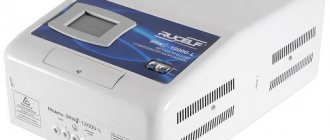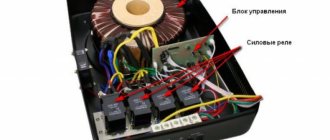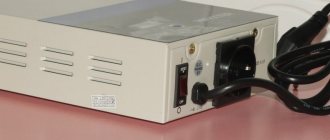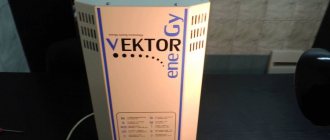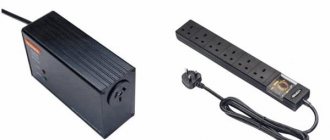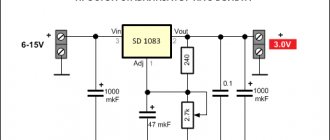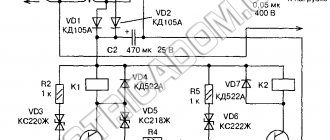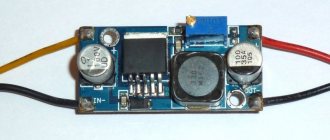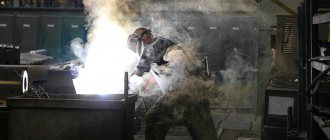Starting currents
Do you want a voltage stabilizer, uninterruptible power supply or generator to operate without failure?
Then this article will be useful for you. One of the main characteristics of household appliances is the electrical power output. It reflects the ability to power the connected load. To correctly select an AC voltage stabilizer, UPS or generator, you need to know the power of the device. To calculate it, you need to calculate the sum of the electrical power of all devices that can be connected at the same time.
One of the main conditions for long and stable operation of the stabilizer, generator and UPS: the power of the equipment should not exceed their output power capabilities. It is better that the total electrical power of electrical appliances that operate simultaneously is 20% less than the output power of the power supply device. The less the stabilizer or UPS operates under overload, the longer it lasts.
The main difficulty lies in calculating the total power. The passport of any device indicates the power in kW. It seems that everything is simple: you need to add up the power of the devices. But therein lies the main mistake. Devices that have electric motors, pumps or compressors in their design, at the moment of startup, place a load on the network that exceeds the nominal value by 2–7 times. This phenomenon is due to the presence of inrush currents. The same rule applies to devices that include inertial components or elements whose physical properties at the time of startup differ from their normal values during operation. A classic example is the change in resistance of an ordinary incandescent lamp. The design of such lamps contains a tungsten filament; when turned on, the electrical resistance of the tungsten is less (the filament is cold) than during operation. Resistance increases with increasing temperature, therefore, when the lamp is turned on, its power is much greater than during operation. When an incandescent lamp is turned on, inrush currents are present.
The power of any device is calculated as the product of voltage (in volts) and current (in amperes). As the current increases, the power increases, which means the load on the stabilizer, generator and power source increases. The definition of starting currents can be formulated as follows: electrical appliances or their elements that have inertial properties, at the moment of starting, place a greater load on the electrical network or power supply than during operation.
The value of starting currents depends not only on the effort to spin the motor or pump rotor to rated speed, but also on the change in conductor resistance. The lower the resistance, the greater the amount of current that can flow through it. When heated, the resistance decreases and the ability of the conductor to pass large currents decreases.
In addition to torque and electrical resistance, inductive power provides additional electrical power to the device at the moment of starting. When the fluorescent lamp is turned on, the inductive coil has low resistance. There is also power to ignite the discharge, which increases the current.
The influence of inrush currents is especially important for voltage stabilizers and on-line uninterruptible power supplies. Stabilizers operate in one of two operating modes: nominal or limit.
In nominal operating mode, power is maintained, but when the quality of power supply deteriorates in the network, very low or, conversely, very high voltage is observed. In this case, the stabilizer goes into maximum operating mode, its output power is reduced by approximately 30%. If an overload of starting currents occurs, it will turn off and the protection system will work. If this is repeated frequently, the service life of a high-quality stabilizer will be short (let alone Chinese technology).
With on-line UPS, things are more complicated. If such a device is subjected to a load that exceeds the rated load (and inrush currents have a very high speed, and they pass any protection), the fuses do not have time to operate, and the power source may burn out. This is a non-warranty case and repairs will cost a significant amount.
The only type of UPS that can withstand inrush currents 2-3 times higher than the rated value is line-interactive backup power supply systems. The maximum starting currents are given by refrigerator compressors (single-chamber - up to 1 kW, double-chamber - up to 1.8 kW), as well as deep-well pumps. Their power during startup exceeds the nominal value by 5–7 times. The smallest starting factor (equal to 2) is observed for Grundfos pumps with a soft start system.
When choosing power supplies or a voltage stabilizer, you need to take into account the time factor of the influence of inrush currents. When you first turn on the stabilizer or generator, all electrical appliances will start working simultaneously and the total load will be large. During further work, the consumer must evaluate the likelihood of simultaneously starting devices with high starting currents (for example, a refrigerator, pump and washing machine). If the stabilizer or UPS has low power, then you should independently control the switching on of equipment with inrush currents.
How to reduce the starting current of a refrigerator?
For decreasing
startup power requires some form of offloading.
For large compressors this is achieved by raising the suction valve(s). Sometimes the soft starter is also included. The best way in your situation would be to switch to the so-called absorption type of refrigerator
.
Interesting materials:
How to disable access to the microphone on Android? How to disable mail ru two-step authentication? How to disable Samsung two-step verification? How to disable two-factor authentication in 1xbet? How to disable the PS Move joystick? How to disconnect PS4 joystick from computer? How to turn off microphone echo in Windows 10? How to disable data saving on Samsung a50? How to disable lock screen on Xiaomi Redmi Note 5? How to turn off the screen of an Asus laptop?
Conclusions:
- When calculating the total power of electrical equipment, the power of devices with starting currents must be calculated not at nominal value, but taking into account the starting currents (in W or A).
- Inrush currents are provided by equipment whose design includes an electric motor, pump, compressor, filament or inductor.
- The worse the voltage in the main wire (below 150 V or above 250 V), the higher the rating of the stabilizer or UPS should be (about 30% more than the total power of the operating equipment).
Inrush currents can be associated with the start of a bicycle's movement: when it starts to move, it takes a lot of force to spin the wheels, but once the bicycle starts moving, less force is required to maintain speed.
Prohibited Troubleshooting Methods
There are several other ways to compensate for the lack of grounding in the room. However, all of them are not authorized, since they can lead to electrical injury and equipment failure.
What not to do:
- Route the grounding wires from the machine body to the water pipes or heating radiator. This option can be dangerous, since the entire riser will be energized.
- Place a rubberized substrate that will serve as a dielectric. In this case, when touching the body of the unit, there will be no short circuit to ground and no current will flow through the person. The malfunction does not go away and can subsequently lead to injury or equipment failure.
- Disconnect the machine's built-in surge protector. It is believed that during a breakdown, this device directs a charge to the body, so turning it off will lead to the disappearance of the current on the surface of the device. The method cannot be called effective, since the cause of the malfunction remains the same. In addition, the washing machine will be left without the built-in protection provided by the surge protector.
It is also not recommended to pull the wire directly from the machine body to the ground on the panel.
When do you need a voltage stabilizer for a refrigerator?
As you understand, a voltage stabilizer for a refrigerator is not always needed and not for everyone. Most often, especially if you live in a large city, in a fairly modern apartment, you most likely will not need it.
Typically, problems with voltage exist where the condition of the electrical networks is not well monitored, the balance of load distribution, and simply where the electrical wiring is old or of poor quality.
You can determine whether you need a voltage stabilizer simply by measuring the voltage in the outlet to which you plan to connect the refrigerator with a multimeter. Normal values will be in the range of 198-242 V, these are the maximum permissible voltage deviations that can occur in a single-phase electrical network according to paragraph 4.2.2 of GOST 32144-2013. Almost all modern refrigerators operate in the range from 220 to 240 Volts, according to their data sheets.
It is best, of course, to make such measurements periodically, at different times of the day, days of the week, and even at different times of the year, because even if at the moment the voltage in the outlet is within the normal range, it is not necessary that this always happens, because there are many factors that can cause sag or surges.
In addition, there are several more indirect indicators by which you can determine that something is wrong with the voltage in an apartment or house:
— Flickering or dim glow of lamps, quite frequent burnout
— Malfunctions in the operation of household appliances: heating elements heat up slowly, transformers hum, timers are reset, appliances do not turn on or fail for no apparent reason, etc.
First of all, if you notice such deviations in the operation of electrical equipment or simply detect too low or high voltage in the network with a multimeter, you should contact your energy supply company and seek to restore the required parameters of the incoming electric current.
Unfortunately, this process, as you understand, is slow, especially if we are talking about low or high voltage in a private house or on a summer cottage, therefore, for some time, you definitely need a voltage stabilizer to protect your refrigerator, allow him to work in normal mode.
Causes
Most often, the washing machine receives an electric shock through the body or its metal parts. Less commonly, a “tingling” sensation is felt through the water or when touching the drum. The reasons can be different - from failure of the heating element, violation of the insulation of wires inside the housing, to grounding and phase short circuits in the panel.
Breakdown of the heating element housing
The heating element is one of the main parts of the washing machine, which is constantly in contact with water. With prolonged use, the heating element breaks down and can “pierce” both the body of the machine and wet things in the drum. With high humidity in the bathroom, breakdown through the wet floor and walls is possible.
Instructions for checking and replacing the heating element - water heater of washing machines
No grounding
The main problem with electrical leakage to the housing is the lack of grounding, that is, a protective conductor (usually a wire marked PE with a yellow-green braid). This problem is most often encountered by residents of high-rise buildings and houses built in the Soviet era - they had an old two-wire network installed in them. However, modern buildings do not always have high-quality grounding. And if there is nowhere to take the parasitic electricity, then it will be discharged to the housing.
Damaged internal wiring
Damage to the insulation of wires inside an electrical appliance can also cause breakdowns. You can get an electric shock from the body, water inside the machine or drum. Damage to internal wiring is much more dangerous than a lack of grounding.
The power button is short
The power button is used more often than others, which leads to contact wear, oxidation and mechanical damage. This in turn leads to short circuits to metal parts and possible current leakage to the housing. But this rarely happens. If the power button shorts, most likely it will be knocked out by the automation, residual current device (RCD) or traffic jams in the entrance.
The control unit is faulty
The control board also has a limited service life (5-7 years), after which short circuits and current breakdowns may occur. In the event of short circuits, automatic power disconnect devices should operate or knock out plugs. If RCDs are not installed and the plugs are designed for 10-16 amperes, the breakdown force can be dangerous.
Breakdown of the motor winding
Breakdowns in the electric motor winding can be caused by liquid leakage onto the motor or natural wear of the part. As a result, interturn short circuits occur, which cause electricity leakage.
Wiring or outlet problems
The problem may also be external. For example, the insulation of the supply wire is broken, or there is a short circuit in the socket or plug. Any of these damages with high humidity can cause a breakdown.
The network noise filter is faulty
The network noise filter regulates frequent changes in electrical energy during operation of the machine and discharges excess current accumulated in the capacitors to the “jacket” or is discharged through a PE wire (conductor). The filter also has a limited service life, as do the capacitors inside. A faulty filter will no longer regulate current differences, which will lead to leakage.
Types of uninterruptible power supplies
The main parameters for dividing the UPS into types: the speed of transition to autonomous mode (powering the refrigerator from the battery) and the parameters of the voltage stabilization option.
On-line (double conversion UPS)
The operating principle of On-line models is based on the double energy transformation method, in which there is no delay when switching the load between the battery and the network. That is, the device is simultaneously constantly in the mode required to stabilize the voltage.
- provide reliable and constant conversion of current from the network to exactly 220 V, that is, they stabilize the power supply online. The required values (pure sinusoidality and maximum compliance with the nominal output) with the best value are maintained both when operating from the mains and from the battery;
- regulate the widest range of vibrations without switching to the battery;
- in the event of a power outage, the transition to the battery is immediate;
- distortions and interference are fully filtered, which makes the output values of the UPS completely independent of the input values;
- return influences of the connected load on the electrical network are eliminated
On-line uninterruptible power supplies are recommended for sensitive electrical appliances, such as a refrigerator. This is the only type of UPS that provides 100% protection.
Line-interactive (line-interactive)
Linear-interactive, like On-line products, with a voltage stabilization option, they include an input regulator, but this function is much weaker: such a model can cope with only minor fluctuations without switching to a battery.
Line-interactive switches to autonomy in milliseconds, but not instantly, like On-line devices. For the main segment of low- and medium-power household appliances, their capabilities are sufficient, but for particularly sensitive devices - refrigerators, washing machines - linear-interactive options can only be recommended conditionally.
Article on the topic: How much does it cost to fill a refrigerator with freon in Ukraine
Line-interactive UPSs will provide some level of safety, but do not guarantee it, that is, significant fluctuations in the model are often missed due to such factors:
- have strong distortion at the output;
- interference is filtered, but not completely;
- Most products do not produce a pure sine wave.
Backup UPS (Off-line)
The most unreliable and simplest type of UPS is backup (Off-line) devices. The scope of functions consists of only two actions:
- automatic switching to battery when the network is disconnected;
- reverse switching.
- do not improve nutritional parameters;
- there is no pure sinusoidality when operating from the battery.
Backup UPSs are appropriate only when the network is stable and for devices that are resistant to poor power quality. This type of uninterruptible power supply is contraindicated for refrigerators. The protection effect will not only be zero, but the device can also negatively affect the unit: the modified sinusoidality harms the compressor.
Other negative nuances:
- poor protection against high-voltage surges and electrical interference;
- low performance - from 5 ms, which is too much for a refrigerator.
Additional Security Measures
To reduce the risk of electric shock, you must adhere to the following safety precautions:
- Touch the body and internal parts of the unit only with dry hands.
- Place laundry in the machine and remove it after washing, having previously unplugged the equipment.
- After work, leave the car door open, or even better, wipe off any remaining moisture. Thus, it is possible to prevent the appearance of corrosion, oxidation of contacts and damage to the integrity of the insulation, increasing the service life of the wiring.
You cannot delay identifying the cause of the malfunction. If it is not possible to determine the breakdown for a long time, you need to contact specialists without waiting until the equipment completely fails.
Examples of rated power and starting power of household appliances
| Type of equipment | Rated power, W | Duration of starting currents, s | Coefficient at start-up | Example of a stabilizer model, VA | UPS model example |
| Fridge | 250–350 | 4 | 3 | "Calm" R1200 / Progress 1500T | N-Power Pro-Vision Black M 3000 LT |
| Washing machine | 2500 | 1–3 | 3-5 | Progress 3000T | |
| Microwave | 1600 | 2 | "Calm" R2000 | ||
| Air conditioner | 2500–3000 | 1–3 | 3-5 | Progress 5000L | |
| Vacuum cleaner | 1500 | 2 | 1.2–1.5 | Progress 3000T | |
| Food processor | 1500–2000 | 2–4 | 7 | Progress 2000T | |
| Dishwasher | 2200 | 1–3 | 3 | Progress 3000L | |
| Submersible well pumps, deep well pumps | 500–1000 | 2 | 3–7 | Progress 3000L | DPK-1/1-3-220-M |
| Circulation pumps | 80–100 | 1–7 | 2–4 | "Calm" R 600 ST | Inelt Intelligent 500LT2 |
| Incandescent lamp | 100 | 0,15 | 5–13 | high precision L series |
The table does not reflect the exact values of electrical appliances; only approximate figures are provided for understanding the algorithm for choosing a voltage stabilizer and UPS.
